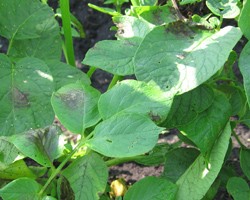Determining Late Blight Sensitivity to Ridomil Takes Time
Carol MacNeil, Extension Vegetable Specialist
Cornell Vegetable Program
September 19, 2013

Aside from one sample each of US-8 in Erie, PA, and WI, a new strain in OH, and one sample of US-24 in ME, all samples submitted have been identified as US-23. Three LB samples were collected 9/2 from two nearby farms in Wayne Co. where two applications of Ridomil did not appear to control LB. A dozen samples collected from the same area 9/9, where LB had continued to increase, were all identified as US-23. While US-8 is resistant to mefenoxam (Ridomil, OLF), and US-24 has variable resistance, US-23, to date, has always been sensitive to mefenoxam. A preliminary test of mefenoxam sensitivity done a few days ago on the 3 original LB samples from the problem fields in Wayne Co. showed US-23 to be sensitive to mefenoxam, but a more definitive test is being done. Pure cultures of those LB samples are needed so the test will take a few weeks.
The % LB diseased foliage in a field significantly affects how well any fungicide works against it. From Bill Fry, Cornell, 9/16/13: "Years ago we did experiments on the effect of timing of Ridomil on the suppression of LB [on a sensitive LB strain]. The treatments included metalaxyl/Ridomil, mancozeb, or no fungicide. We initiated applications at ~0.5% disease or at 2-5% diseased [foliage]. The effects of Ridomil were apparent within a day or two, but the effects of mancozeb were not visible for at least one week. LB increased explosively in the mancozeb and untreated plots for the first week. Subsequently, mancozeb did slightly suppress disease relative to the water control. The effect of Ridomil was dramatically different with an immediate observable effect in [reducing disease development]. Nonetheless, the amount of disease in the Ridomil plots continued to increase gradually for the next four weeks. When we initiated Ridomil applications at 0.5% disease the final level of disease was less, and the rate at which disease increased was less, than when we began at 2-5% diseased foliage. There was inoculum from other plots that probably contributed to increased LB. Thus, once disease is established, it's really difficult to totally stop this pathogen. I suspect that given the wet weather and favorable conditions we've had recently, any fungicide may have been challenged."
If mefenoxam (Ridomil, OLF) is not working on your farm rotate to a LB fungicide such as Previcur Flex plus protectant, Ranman plus, Revus Top or Forum plus. If you're close to potato vine-kill use a fungicide good against tuber blight such as Gavel, Zoxium plus protectant, Ranman plus, or Forum plus. (Info from T. Zitter, 7/12/13)
If you think Ridomil is not working, or if you have questions regarding LB, contact Carol MacNeil.

Upcoming Events
2026 Finger Lakes Produce Auction Winter Growers Meeting
January 8, 2026
Penn Yan, NY
At this vegetable grower-focused meeting, ag industry experts will discuss food safety, disease management in strawberries, the benefits of using cover crops, plus more. Two grower panel discussions will focus on pest management techniques and irrigation. DEC recertification credits offered in categories 10, 1a, 21, 22, 23, and 24.
2026 Ontario Produce Auction Winter Growers Meeting
January 14, 2026
Stanley, NY
At this grower-focused meeting, ag industry experts will discuss European Cherry Fruit Fly, greenhouse phytosanitary inspections, the benefits of using cover crops, plus more. Two grower panel discussions will focus on pest management techniques. DEC recertification credits offered in categories 10, 1a, 22, 23, and 24.


































